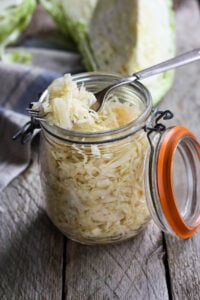Description
Making homemade Sauerkraut is easier than you think! Full of healthy probiotics that support our gut and boost our immune system, sauerkraut is fermented cabbage that takes under 30 minutes of hands-on time before mother nature takes over!
Ingredients
- 1-2 heads of cabbage, about 2 pounds (1000 grams)
- Mineral or sea salt (not iodized)- ( 20 grams based on 1000 grams of cabbage). Or multiply .02 x the grams of cabbage, see notes)
Instructions
- Set aside 2 cabbage leaves and leave them whole.
- Shred the remaining cabbage finely with a sharp knife or mandolin. Weigh the cabbage in grams (careful not to include the bowl’s weight). Take this number and multiply it by .02. This is the number in grams of salt you will need, so measure this out.
- Massage the measured salt into the cabbage. (Let sit 30 minutes, or longer if needed to extract more juices).
- Transfer cabbage and brine to your vessel and pack tightly with a tamper, or a muddler.
- Leave 3 inches of space between brine level and the top of the jar. Top with one or two cabbage leaves to keep shreds from floating above the brine add a fermentation weight.
- Keep the jars at room temperature (65-72F is ideal). Check progress daily making sure cabbage is still submerged ( pushing it down if not) and taste for doneness starting day 3. It will generally take anywhere from 3-5 days and will get sourer as it ferments.
- You will know that it is adequately fermented when it looks lighter in color, with a pleasantly tangy flavor.
- Store in the refrigerator with a sealed lid. To create a bubbly kraut, burping on occasion.
Notes
Salt Ratio: The recommended salinity for Sauerkraut is 1.5% – to 2.5% salt to the weight of the cabbage. Here we use 2% salt to the weight of the cabbage. Example: 1ooo grams cabbage multiplied x .02= 2o grams of salt. Feel free to use more or less as long as it stays between 1.5% and 2.5%. I use Himalayan Sea Salt and Real Salt. Both are natural and unrefined with high mineral content.
How to store: Cold temperatures (refrigeration or a root cellar if you are so lucky!) slow down the fermentation process. Make sure you store your kraut in its brine, and it will keep for at least 6 months.
Flavors: Feel free to add flavorings to the kraut- caraway seeds, fresh ginger, fresh turmeric, onion, garlic cloves, dill or dill seeds, etc.
Nutrition
- Serving Size: ¼ cup
- Calories: 35
- Sugar: 4.3 g
- Sodium: 728.3 mg
- Fat: 0.2 g
- Saturated Fat: 0 g
- Carbohydrates: 8.4 g
- Fiber: 2.4 g
- Protein: 1.6 g
- Cholesterol: 0 mg
